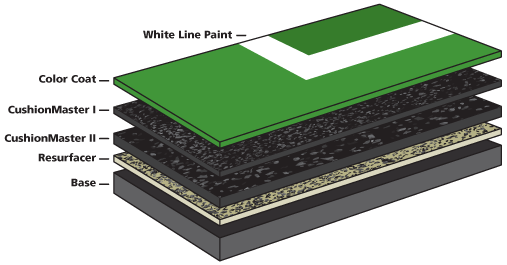Pickleball Court Construction Cost Overview-- What to Expect
Pickleball Court Construction Cost Overview-- What to Expect
Blog Article
Sustainable Practices in Pickleball Court Building You Must Know
As the appeal of pickleball proceeds to climb, so too does the requirement for lasting techniques in court building. The effect of these techniques expands far past the court itself.
Picking Eco-Friendly Materials
Choosing environment-friendly products is an essential action in the building of sustainable pickleball courts. The choice of lasting products not only lessens ecological impact however also enhances the durability and efficiency of the court. Key materials include recycled rubber for the surface, which provides superb resilience and shock absorption while diverting waste from garbage dumps.
Furthermore, using in your area sourced products lowers transportation emissions and supports local economies. Pickleball court construction. Utilizing native woods for secure fencing and seats can supply a sustainable visual while ensuring strength versus the elements.
Including absorptive products for court foundations can further add to sustainability by permitting for natural water drain and decreasing runoff. These options not just safeguard local communities yet also advertise healthier play environments.
Efficient Drain Solutions
While the option of green materials is crucial, carrying out reliable drainage services is similarly critical for preserving lasting pickleball courts. Correct water drainage not just protects the court surface area from water damages however also lessens disintegration and drainage, advertising ecological integrity.
Effective water drainage systems can include permeable paving, which allows water to infiltrate the ground rather than pooling externally. This lowers the likelihood of standing water, which can result in mold and other maintenance issues. In addition, including purposefully put drain channels and swales can direct excess water far from the court area, making sure a dry playing surface area and avoiding soil disintegration.
Utilizing indigenous plants in the landscaping around the courts can further enhance drain by absorbing excess water and decreasing overflow. These plants require less watering and promote biodiversity, aligning with sustainable practices.
In addition, it is important to on a regular basis maintain the drain system to ensure its long-lasting performance. This includes clearing particles and monitoring for obstructions. By prioritizing efficient water drainage options, pickleball court producers can dramatically add to the sustainability and durability of the center, ultimately profiting both gamers and the setting.
Energy-Efficient Lighting Options
As the demand for pickleball proceeds to expand, incorporating energy-efficient illumination options into court layout has actually become progressively crucial for sustainability. Standard lights systems often consume excessive energy, adding to greater functional prices and ecological influence. Therefore, adopting modern, energy-efficient innovations is vital for both new building and constructions and improvements.
LED (Light Emitting Diode) lights sticks out as a leading selection as a result of its durability and power financial savings (Pickleball court construction). Compared to standard illumination, LEDs use about 75% less power and can last as much as 25 times longer, significantly minimizing upkeep costs. The directional nature of LED lights reduces light air pollution, guaranteeing that lighting is focused on the court rather than bordering locations.

Sustainable Surface Area Alternatives
Exploring lasting surface area alternatives for pickleball courts has gotten grip amongst contractors and gamers alike. The emphasis on environmentally friendly materials not only lines up with the growing ecological recognition yet additionally enhances the performance and resilience of the courts.
One prominent option is making use of recycled rubber, which can be sourced from made use of tires. This product supplies superb shock absorption, lowering the risk of injuries for players while advertising sustainability. Furthermore, modular tiles made from recycled plastics provide an additional viable alternative. These tiles are very easy to install and change, and their adaptability permits for various court setups.
Natural lawn courts are also arising as a sustainable selection, advertising biodiversity and decreasing the warmth island impact. However, they require routine maintenance and water, which may not align with all sustainability goals.

Water Preservation Techniques

An additional effective method involves the installation of rainwater you can look here harvesting systems. These systems store and accumulate rain for use in preserving court surfaces and landscaping. This technique not just preserves drinkable water however additionally decreases dependence on community resources.
Additionally, using drought-resistant view landscape design around the courts is essential. Indigenous plants call for less water and are much better adjusted to local environment problems, thus reducing general water intake. In addition, utilizing reliable watering systems, such as drip watering, makes certain that water is supplied straight to plant roots, reducing dissipation and waste.
Verdict
Including lasting techniques in pickleball court building and construction significantly contributes to environmental preservation and resource effectiveness. By prioritizing these practices, the building and construction of pickleball courts can align with wider ecological objectives while advertising long life and functionality within communities.
As the appeal of pickleball continues to increase, so too does the demand for lasting techniques in court building.Selecting environmentally friendly materials is a critical action in the building and construction of lasting pickleball courts. By focusing on energy-efficient lights choices, pickleball court fabricators can add to a much more lasting future while fulfilling the needs of players and stakeholders alike.Integrating lasting surface area choices not just improves the performance of pickleball courts yet likewise leads the way for implementing reliable water conservation techniques.Integrating sustainable practices in pickleball court building significantly contributes to environmental conservation and source efficiency.
Report this page